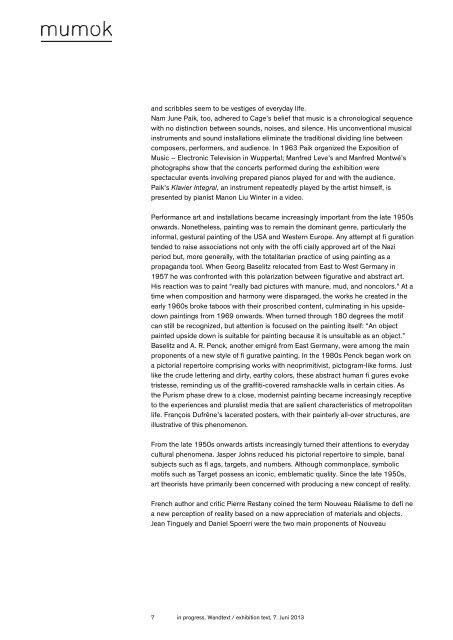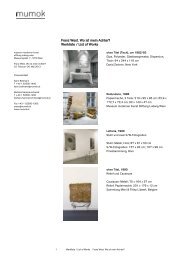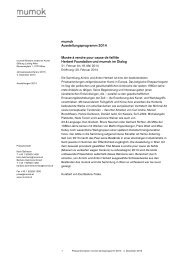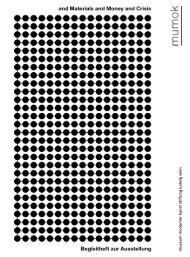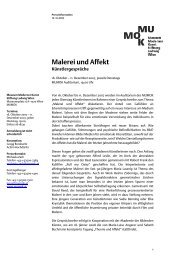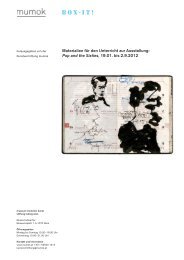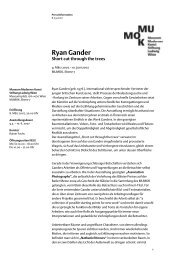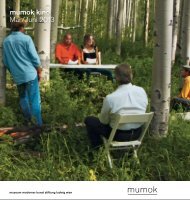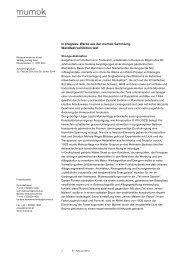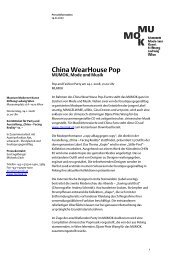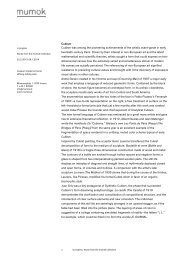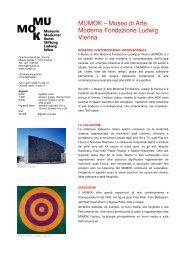in progress. Werke aus der mumok Sammlung Wandtext/exhibition text
in progress. Werke aus der mumok Sammlung Wandtext/exhibition text
in progress. Werke aus der mumok Sammlung Wandtext/exhibition text
Erfolgreiche ePaper selbst erstellen
Machen Sie aus Ihren PDF Publikationen ein blätterbares Flipbook mit unserer einzigartigen Google optimierten e-Paper Software.
and scribbles seem to be vestiges of everyday life.<br />
Nam June Paik, too, adhered to Cage’s belief that music is a chronological sequence<br />
with no dist<strong>in</strong>ction between sounds, noises, and silence. His unconventional musical<br />
<strong>in</strong>struments and sound <strong>in</strong>stallations elim<strong>in</strong>ate the traditional divid<strong>in</strong>g l<strong>in</strong>e between<br />
composers, performers, and audience. In 1963 Paik organized the Exposition of<br />
Music – Electronic Television <strong>in</strong> Wuppertal; Manfred Leve’s and Manfred Montwé’s<br />
photographs show that the concerts performed dur<strong>in</strong>g the <strong>exhibition</strong> were<br />
spectacular events <strong>in</strong>volv<strong>in</strong>g prepared pianos played for and with the audience.<br />
Paik’s Klavier Integral, an <strong>in</strong>strument repeatedly played by the artist himself, is<br />
presented by pianist Manon Liu W<strong>in</strong>ter <strong>in</strong> a video.<br />
Performance art and <strong>in</strong>stallations became <strong>in</strong>creas<strong>in</strong>gly important from the late 1950s<br />
onwards. Nonetheless, pa<strong>in</strong>t<strong>in</strong>g was to rema<strong>in</strong> the dom<strong>in</strong>ant genre, particularly the<br />
<strong>in</strong>formal, gestural pa<strong>in</strong>t<strong>in</strong>g of the USA and Western Europe. Any attempt at fi guration<br />
tended to raise associations not only with the offi cially approved art of the Nazi<br />
period but, more generally, with the totalitarian practice of us<strong>in</strong>g pa<strong>in</strong>t<strong>in</strong>g as a<br />
propaganda tool. When Georg Baselitz relocated from East to West Germany <strong>in</strong><br />
1957 he was confronted with this polarization between figurative and abstract art.<br />
His reaction was to pa<strong>in</strong>t “really bad pictures with manure, mud, and noncolors.” At a<br />
time when composition and harmony were disparaged, the works he created <strong>in</strong> the<br />
early 1960s broke taboos with their proscribed content, culm<strong>in</strong>at<strong>in</strong>g <strong>in</strong> his upsidedown<br />
pa<strong>in</strong>t<strong>in</strong>gs from 1969 onwards. When turned through 180 degrees the motif<br />
can still be recognized, but attention is focused on the pa<strong>in</strong>t<strong>in</strong>g itself: “An object<br />
pa<strong>in</strong>ted upside down is suitable for pa<strong>in</strong>t<strong>in</strong>g bec<strong>aus</strong>e it is unsuitable as an object.”<br />
Baselitz and A. R. Penck, another emigré from East Germany, were among the ma<strong>in</strong><br />
proponents of a new style of fi gurative pa<strong>in</strong>t<strong>in</strong>g. In the 1980s Penck began work on<br />
a pictorial repertoire compris<strong>in</strong>g works with neoprimitivist, pictogram-like forms. Just<br />
like the crude letter<strong>in</strong>g and dirty, earthy colors, these abstract human fi gures evoke<br />
tristesse, rem<strong>in</strong>d<strong>in</strong>g us of the graffiti-covered ramshackle walls <strong>in</strong> certa<strong>in</strong> cities. As<br />
the Purism phase drew to a close, mo<strong>der</strong>nist pa<strong>in</strong>t<strong>in</strong>g became <strong>in</strong>creas<strong>in</strong>gly receptive<br />
to the experiences and pluralist media that are salient characteristics of metropolitan<br />
life. François Dufrêne’s lacerated posters, with their pa<strong>in</strong>terly all-over structures, are<br />
illustrative of this phenomenon.<br />
From the late 1950s onwards artists <strong>in</strong>creas<strong>in</strong>gly turned their attentions to everyday<br />
cultural phenomena. Jasper Johns reduced his pictorial repertoire to simple, banal<br />
subjects such as fl ags, targets, and numbers. Although commonplace, symbolic<br />
motifs such as Target possess an iconic, emblematic quality. S<strong>in</strong>ce the late 1950s,<br />
art theorists have primarily been concerned with produc<strong>in</strong>g a new concept of reality.<br />
French author and critic Pierre Restany co<strong>in</strong>ed the term Nouveau Réalisme to defi ne<br />
a new perception of reality based on a new appreciation of materials and objects.<br />
Jean T<strong>in</strong>guely and Daniel Spoerri were the two ma<strong>in</strong> proponents of Nouveau<br />
7 <strong>in</strong> <strong>progress</strong>. <strong>Wand<strong>text</strong></strong> / <strong>exhibition</strong> <strong>text</strong>, 7. Juni 2013


